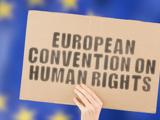What's in the Human Rights Act?
This page highlights some of the key areas of the Human Rights Act and what is actually included. It is only a summary and you can read the Human Rights Act in full on legislation.gov.uk.
The Human Rights Act (HRA) 1998 was passed by the UK Parliament with support from both Labour and Conservative party members. It brings the rights in the European Convention on Human Rights (ECHR) into UK law.
This guide will explain what is actually in the HRA, and although not everything has been included, we have focused on what we think are the most important bits. Our focus is on Schedule 1, where you’ll find the list of rights, as well as the sections that help us put the Act into practice.
Section 2: Interpretation of Convention rights
Section 2 of our Human Rights Act (HRA) says courts in the UK must ‘take into account’ any relevant cases decided by the European Court of Human Rights (ECtHR). It does not require UK courts to follow what the ECtHR has decided.
Section 2 in Action: Elan-Cane v Secretary of State for the Home Department
Christie Elan-Cane is non-binary and brought a case against the Home Office, saying the lack of a gender-neutral option on the passport form was a breach of their Article 8 right to private and family life. The court held that the current passport policy did not breach that right. It looked at ECtHR case law and said that while approaches to gender-identity issues worldwide are "moving towards the recognition of the status of non-binary people, there is, as yet, nothing approaching a consensus" and that it is "primarily for the Contracting States to decide on the measures necessary to secure Convention rights within their jurisdiction". This means it is up to individual States, like the UK, to decide how to protect the human rights in the Convention.
"The very recent Elan-Cane case is very interesting, because, as Lord Mance said, to some extent it settles the question of how far the courts can go in the interpretation of the convention beyond what the Strasbourg court has indicated might be necessary, because there exists what is called a margin of appreciation.” - Dr Tyrrell, JCHR Oral Evidence Sessions, 26th January 2022
Section 3: Interpretation of legislation
Section 3 of our HRA means that any UK laws must be applied in a way which respects our human rights, as far as it is possible to do so. We call it, “the interpretive obligation”. This applies to the courts but also to public authorities acting under the power of other laws such as the Mental Health Act 1983. This also means that when the law gives public officials a choice, they must choose the option that respects human rights. We call this “looking at laws through a human rights lens".
When this doesn’t happen individuals can seek justice in the courts. Whilst courts can never overrule an Act of the UK Parliament, where possible they can apply other laws compatibly with human rights. This is a key form of accountability that ensures human rights are effective in the UK.
The court can disapply (i.e. not follow) secondary legislation - such as rules and regulations - that doesn't respect human rights. This is because secondary legislation is not passed by Parliament so is not protected by parliamentary sovereignty. The court can only disapply secondary legislation if doing so is not prevented by any Acts of Parliament.
Section 3 in Action: Kirsten's Story
Kirsten is a single parent of an autistic son who, from the ages of 14-18, was held in mental health hospitals under the Mental Health Act. He was subjected to restrictive practices, including mechanical restraint, such as handcuffs, leg belts, and being transported in a cage, and long periods in seclusion.
“The Mental Health Act gave legal powers to put my child in a seclusion cell for weeks at a time. It gave powers to put my child in metal handcuffs, leg belts and other forms of mechanical restraints. It gave powers to transport him in a cage from one hospital to another…As a parent, [Section 3 of] the Human Rights Act gave me the legal framework to challenge decisions. This was so important for me as a parent facing the weight of professionals who seemed to have so much power over mine and my son’s lives. I used the Human Rights Act to make timely and meaningful change to my own son’s care and treatment.” – Kirsten
Section 4: Declaration of incompatibility
If a court decides the HRA has not been followed or if a law passed by Parliament does not support the rights in the HRA then the courts can issue a Declaration of Incompatibility under Section 4 of our HRA. This is the court saying that it believes that a particular law is not compatible with the rights in the HRA. This does not automatically change the law. Instead, it is the responsibility of Parliament to decide whether to change the law or not. This demonstrates how parliamentary sovereignty works.
Section 4 in Action: Bellinger v Bellinger
Elizabeth Bellinger was a transgender women who wanted to marry a cisgender man. She was not able to because the Matrimonial Causes Act 1973 at the time only allowed marriage between a man and a woman and there was no way for Elizabeth to change her legally recognised gender. The Civil Partnership Act 2004 was also not in force at the time.
The House of Lords made a Declaration of Incompatibility under Section 4 of the HRA, stating the Matrimonial Causes Act breached the Article 8 right to private and family life and the Article 12 right to marry.
Cases like Elizabeth's meant that the Gender Recognition Act 2004 was brought in, in recognition of the fact that "legislation was needed to enable transgender people to marry in their new gender".
Section 6: Acts of public authorities
Section 6 of our HRA places a duty on all public authorities to act in a way that is compatible with the rights in the Act wherever possible. They can only act in a way that breaches human rights if the law gives them no other choice. Public authorities includes courts, tribunals and any person who performs public functions. This includes people like NHS workers and social workers as well as private organisations that are contracted by the Government, such as housing associations.
There is no exhaustive list of who is counted as a public body. The Joint Committee on Human Rights says this was done intentionally, to “provide as much protection as possible for the rights of the individual against the misuse of power by the State”. At Paragraph 18 in their report, Parliament’s Joint Committee on Human Rights said it is clear that a choice was made not to just list the bodies that have legal human rights responsibilities because this would potentially limit people’s ability to access an effective remedy for human-rights breaches. The right to an effective remedy is set out in Article 13 of the European Convention on Human Rights.
Section 6 in Action: Sarah's Story
Sarah works in a large NHS Trust which has been using the Human Rights Act to create positive change for people accessing services. The Trust has been doing specific work around restraint, seclusion and restrictive practices using the framework provided by the HRA for rights-respecting decision making and better outcomes for individuals and their families/loved ones.
"The duty to protect the right to life means that sometimes we will use restrictive practices to keep the person safe and alive so we will use interventions such as restraint and seclusion. [Section 6 of] the HRA provides us with an objective legal framework for examining those decisions and ensuring that what we are doing and how we are doing it is a lawful, legitimate and proportionate restriction of Articles 8 (psychological and physical integrity) and 5 (liberty) and that we don’t risk breaching people’s Article 3 rights freedom from inhuman and degrading treatment. I think consideration of the proportionality of the intervention is particularly important as it encourages us to explore other less restrictive interventions. So, for example we can restrain someone in a compassionate, caring way by talking to them when they are well about how to do it, talking to them all the way through the restraint and debriefing them afterwards.
In short, the Human Rights Act has given us a legal, objective, decision making framework, provided by no other law or policy, to ensure rights are protected and people and staff are safe." – Sarah
Section 7: Acts of public authorities
Section 7 of our HRA says that if a public body breaches Section 6, the person affected can bring legal proceedings against them (but only if they are the “victim”). They should typically start the proceedings within one year of the breach but the court may allow them to bring a case later if they think it’s fair in the circumstances.
Section 19: Statement of compatibility
Section 19 of our HRA requires Government Ministers who want to make a new law to tell Parliament whether or not it is compatible with human rights. Parliament's Joint Committee on Human Rights says this is important because it “drive[s] a process within government that ensures human rights concerns are taken seriously.”
Section 19(1)(b) means the Minister can say that even though they can't say their new law is compatible with human rights, they want to introduce it anyway. Parliament can choose to do so because of the principle of parliamentary sovereignty (that Parliament is the ultimate power in the UK and cannot be overruled).
Schedule 1: The Articles
Schedule 1 of our HRA lists the rights that have been brought over from the European Convention on Human Rights.
Article 2 ‐ Right to life. You have the right to life.
Article 3 ‐ Prohibition of torture. No one ever has the right to hurt you or torture you. Even in detention your human dignity has to be respected.
Article 4 ‐ Prohibition of slavery and forced labour. It is prohibited to treat you as a slave or to impose forced labour on you.
Article 5 ‐ Right to liberty and security. You have the right to liberty. If you are arrested, you have the right to know why. If you are arrested you have the right to stand trial soon, or to be released until the trial takes place.
Article 6 ‐ Right to a fair trial. You have the right to a fair trial before an unbiased and independent judge. If you are accused of having committed a crime, you are innocent until proved guilty. You have the right to be assisted by a lawyer who must be paid by the state if you are poor.
Article 7 ‐ No punishment without law. You cannot be held guilty of a crime if there was no law against it when you did it.
Article 8 ‐ Right to respect for private and family life. You have the right to respect for your private and family life, your home and correspondence.
Article 9 ‐ Freedom of thought, conscience, and religion. You have the right to freedom of thought, conscience, and religion. You have the right to practise your religion at home and in public and to change your religion if you want.
Article 10 ‐ Freedom of expression. You have the right to responsibly say and write what you think and to give and receive information from others. This includes freedom of the press.
Article 11 ‐ Freedom of assembly and association. You have the right to take part in peaceful meetings and to set up or join associations ‐ including trade unions.
Article 12 ‐ Right to marry. You have the right to marry and to have a family.
Article 14 ‐ Prohibition of discrimination. You have these rights regardless of your skin colour, sex, language, political or religious beliefs, or origins.
Related topics
Find out more about UK human rights law.
Stay up-to-date
Get our newsletter
Get monthly updates on UK human rights law and our work, resources and events sent straight to your inbox.




